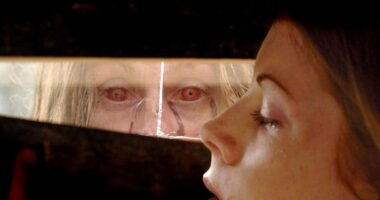From friendly smiley faces to cheeky aubergines, emoji now form a staple part of many of our messages.
While most popular characters are harmless fun, other seemingly-innocent symbols have secret sinister meanings.
Viewers of the popular Netflix series, Adolescence, were surprised to discover the hidden interpretations of emojis such as ‘100’, pill, beans, and orange heart.
However, this is just the tip of the iceberg.
MailOnline’s interactive chart reveals the true meaning of 60 popular emoji.
Some of the emoji – including the pill, mushroom, and balloon – are code for drugs, while others have Neo-Nazi connotations.
And if you spot your child sending a fruit emoji, it could indicate that they’re talking about sex.
So, do you know the meanings behind these ‘sinister’ emoji? Hover over each character to find out what it really means.
MailOnline’s interactive chart is based on a table created by education charity, For Working Parents.
It exposes 60 seemingly innocent symbols being used to hide disturbing messages across six categories.
This includes drugs, violence, sex, self-harm, extremism, and incels (involuntary celibates).
Amit Kalley, the creator of For Working Parents, advised parents to continue investigating and posing relevant inquiries about their kids’ online activities.
He stated on Instagram, ‘I designed it to bring attention and provide a useful resource for parents to initiate crucial discussions with their children.’
‘It’s not exhaustive and, of course, it can be interpreted in ways not intended.’
Drugs
The table includes 11 emoji that are secretly related to drugs.

The ‘snowman’, ‘snowflake’, or ‘eight ball’ emoji can all be used as code for the various slang names of cocaine

‘Every generation has its own drug slang, and the terms and shorthand change with every passing decade,’ Bark explained
The ‘snowman’, ‘snowflake’, or ‘eight ball’ emoji can all be used as code for the various slang names of cocaine.
Marijuana, meanwhile, can be represented by a wide range of emoji including herbs, leaves, trees, or other plants.
The horse emoji might be used to refer to the horse tranquiliser and popular recreational drug ketamine, while the mushroom refers to magic mushrooms.
Two popular emoji – the candy and the pill – can be used as code for MDMA, while the dragon refers to heroin, and the balloon to nitrous oxide (laughing gas).
Finally, if you see the phone and money emoji being used in conjuction, this may be code for a drug dealer.
‘Every generation has its own drug slang, and the terms and shorthand change with every passing decade,’ Bark explained.
‘For Gen Z, it’s a little different. Kids today talk about drugs in a way that adds a new twist, using a language they’re fluent in — emojis.
‘These emojis can look like ordinary, harmless symbols, which means parents may easily overlook them.’

Unsurprisingly, the water gun and knife emoji refer to weapons, while the dynamite and pirate flag simply refer to crime in general
Violence
Ten emoji have been linked to violence, according to For Working Parents.
Unsurprisingly, the water gun and knife refer to weapons, while the dynamite and pirate flag simply refer to crime in general.
The ‘face with crosses for eyes’ and skull emoji can be used as code for murder.
And while you might think that the ambulance would be a safe emoji to see on your child’s phone, this may actually be code for a threat.
The lock and key refer to being ‘locked up’, while the musical note may be a reference to trap music, and the rat emoji could be code for ‘snitch’.
While no emoji are illegal, the knife and gun are the most common emoji to arise in trials, according to Dr Zakeera Docrat, a forensic linguist from the University of the Western Cape.
‘At the moment we are seeing a scourge of sexual violence and gender-based violence,’ Dr Docrat told MailOnline.

The biggest group is for emoji that refer to sex. Several of these are fairly well known – including the aubergine (penis), peach (bum), tongue (oral sex), and finger (fingering)
‘Many perpetrators are opting to use non-verbal communication – emoji – with the view that if it is not in written text or speech there is no crime committed.
‘In these types of cases, there is an increase in the use of the aubergine, peach, strawberry, peeled banana, kiss emoji, red heart and the liquid drops.’
Sex
The biggest group is for emoji that refer to sex.
Several of these are fairly well known – including the aubergine (penis), peach (bum), tongue (oral sex), and finger (fingering).
However, others will probably surprise you.
According to For Working Parents, the donut emoji is code for anal sex, the hotdog means penis, and the cherries refer to genitalia.
Meanwhile, the brain emoji refers to oral sex, the corn is code for porn, and the taco could refer to a vagina.

According to For Working Parents, the donut emoji is code for anal sex, the hotdog means penis, and the cherries refer to genitalia
Self-harm
For Working Parents highlights four emoji linked to self-harm.
The scissors may refer to cutting, while the flame could be code for burning.
Meanwhile, the rain cloud could indicate that your child is feeling low, while the combination of the plate and red cross could suggest they’re not eating.
Extremism
Six popular emoji may be linked to extremism, according to For Working Parents.
The ‘OK’ hand gesture may be code for Far Right, while the crossed swords and black flag are linked with extremism more generally.
If you see the hedgehog, lightning bolt, or 1488 emoji, meanwhile, it may be a reference to Neo-Nazis.

The ‘OK’ hand gesture may be code for Far Right, while the crossed swords and black flag are linked with extremism more generally
Speaking to the BBC, Jonathan Greenblatt, boss at the Anti-Defamation League (ADL), explained: ‘Even as extremists continue to use symbols that may be years or decades old, they regularly create new symbols, memes and slogans to express their hateful sentiments.
‘We believe law enforcement and the public needs to be fully informed about the meaning of these images, which can serve as a first warning sign to the presence of haters in a community or school.’
Incel
As a primarily online movement, several emoji have been co-opted by incels looking to proclaim their ideological allegiance or by their opponents to brand men as incels.
In particular, the pill emoji is used to show whether someone shares incel beliefs.
In an article for The Conversation, Dr Robert Lawson, an expert on sociolinguistics from Birmingham City University, says: ‘The cyberpunk blockbuster The Matrix is the source of a key symbol in the manosphere – the red pill.’
Just like in The Matrix, manosphere influencers describe adopting misogynist views as ‘taking the red pill’ and waking up from the illusions of the ‘Matrix’ of conventional thought.
Dr Lawson continues: ‘In the manosphere, those who have been ‘red-pilled’ see the world as it really is, understanding the so-called ‘real’ nature of women’s behaviour and dating preferences.’


In Adolescence, DI Bascome learns that manosphere-related emoji include the kidney bean emoji (left) and the ‘100 points’ emoji (right)
In Adolescence, DI Bascome, played by Ashley Walters, is also told that a dynamite emoji represents an ‘exploding red pill’ – meaning that someone is an incel.
Likewise, Adam explains how the ‘100’ emoji is another incel symbol, related to the ’80 to 20 rule.’
’80 per cent of women are attracted to 20 per cent of men,’ he tells his dad.
‘Women, you must trick them because you’ll never get them in a normal way.’
Finally, Adam claims that a ‘kidney bean’ emoji commented on someone’s post can be used to say that this person is an incel.
This emoji’s links to the manosphere are less clear but it could be a connection to the coffee emoji which has become a manosphere dog whistle in recent years.
Based on an older meme circulated on the messaging board 4Chan and Reddit, the coffee emoji or the phrase ‘women coffee’ is sometimes used to mock or deride women.
Since the ‘bean’ emoji could also represent a coffee bean, it is possible that it has taken on some of the sexist meanings of the original coffee meme.

















